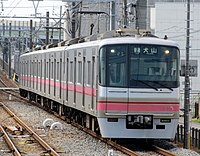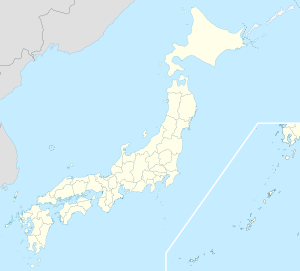Kasugai, Aichi
 From Wikipedia - Reading time: 10 min
From Wikipedia - Reading time: 10 min
Kasugai
春日井市 | |
|---|---|
 Interactive map outlining Kasugai | |
 Location of Kasugai in Aichi Prefecture | |
| Coordinates: 35°14′51″N 136°58′20″E / 35.24750°N 136.97222°E | |
| Country | Japan |
| Region | Chūbu (Tōkai) |
| Prefecture | Aichi |
| Government | |
| • – Mayor | Naoki Ishiguro (since May 2022) |
| Area | |
• Total | 92.78 km2 (35.82 sq mi) |
| Population (October 1, 2019) | |
• Total | 306,764 |
| • Density | 3,300/km2 (8,600/sq mi) |
| Time zone | UTC+9 (Japan Standard Time) |
| – Tree | Zelkova serrata |
| – Flower | Sakura |
| Phone number | 81-(0)568-81-5111 |
| Address | Toriimatsu 5–44, Kasugai City, Aichi Prefecture 486-8686 |
| Website | Official website |
Kasugai (春日井市, Kasugai-shi) is a city in Aichi Prefecture, Japan. As of 1 October 2019[update], the city had an estimated population of 306,764,[1] and a population density of 3,306 persons per km2. The total area of the city is 92.78 square kilometres (35.82 sq mi). The city is sometimes called Owarikasugai to avoid confusion with other municipality of the same name, including Kasugai (now part of Fuefuki) in Yamanashi Prefecture.
Geography
[edit]Kasugai is located in northwest Aichi Prefecture, north of the Nagoya metropolis, in the northern Nōbi Plain. The Shōnai River flows through the southern portion of the city.
Climate
[edit]The city has a climate characterized by hot and humid summers, and relatively mild winters (Köppen climate classification Cfa). The average annual temperature in Kasugai is 15.8 °C. The average annual rainfall is 1681 mm with September as the wettest month. The temperatures are highest on average in August, at around 28.2 °C, and lowest in January, at around 4.3 °C.[2]
Demographics
[edit]Per Japanese census data,[3] the population of Kasugai has increased rapidly over the past 70 years with the 1960s being the fastest growing decade.
| Year | Pop. | ±% |
|---|---|---|
| 1940 | 39,942 | — |
| 1950 | 64,346 | +61.1% |
| 1960 | 77,174 | +19.9% |
| 1970 | 161,835 | +109.7% |
| 1980 | 244,119 | +50.8% |
| 1990 | 266,599 | +9.2% |
| 2000 | 287,623 | +7.9% |
| 2010 | 305,662 | +6.3% |
Surrounding municipalities
[edit]History
[edit]The area which is now Kasugai contains many Kofun period burial mounds. During the Edo period, the area was mostly part of the holdings of Owari Domain.
With the Meiji period establishment of the modern municipalities system, the area was organized into villages under Higashikasugai District, including the village of Kachigawa on October 1, 1889. Kachigawa was raised to town status on July 25, 1900. On June 1, 1943, Kachigawa was merged with neighboring villages of Toriimatsu and Shinogi to form the city of Kasugai, and in 1958, Kasugai annexed the neighboring towns of Sakashita and Kōzōji.
Kasugai gained special city status on April 1, 2001, with increased local autonomy.
Government
[edit]
Mayor-council
[edit]Kasugai has a mayor-council form of government with a directly elected mayor and a unicameral city legislature of 32 members.
Prefectural Assembly
[edit]The city contributes four members to the Aichi Prefectural Assembly.
House of Representatives
[edit]In terms of national politics, the city is part of Aichi 6th district of the lower house of the Diet of Japan.
Sister cities
[edit]International
[edit]- Sister cities
| City | Country | State | Since |
|---|---|---|---|
| Kelowna | British Columbia | February 5, 1981[4] |
National
[edit]- Disaster alliance city
| City | Prefecture | Region | Since |
|---|---|---|---|
| Ōgaki | Chūbu region | August 25, 2011 | |
| Kasuga | Kyūshū region | August 7, 2012 | |
| Aomori | Tōhoku region | October 10, 2012 |
Economy
[edit]
Due to its location, Kasugai is increasingly becoming a bedroom community for the greater Nagoya metropolis.
In terms of agricultural production, Kasugai is noted for horticulture and produces over 80% of the cactus sold as houseplants. Oji Paper Company, Panasonic and Fujitsu have large factories in Kasugai. There are also several shopping centers in Kasugai, including APiTA Kōzōji (SUN MARCHÉ), Æon Kasugai shopping center, Shimizuya, and The Mall Kasugai.
Companies headquartered in Kasugai include Aichi Electric, Amiyaki Tei, Daito ME, Chita Kogyo, Toyo Electric Corporation, KDK (Panasonic Ecology Systems), Panasonic Industrial Devices SUNX, Fine Sinter, and Mitsuchi Corporation.
Education
[edit]
University
[edit]Colleges and universities:
- Chubu University
- Meijo University, Kasugai campus
Primary and secondary education
[edit]- Kasugai has 37 public elementary schools and 15 public junior high schools operated by the city government, and seven public high schools operated by the Aichi Prefectural Board of Education. Chubu University owns one private junior high school and one private high school on its campus. The prefecture also operates two special education schools for the handicapped.
International schools
[edit]- Toshun Korean Primary School (東春朝鮮初級学校) – North Korean school[5]
Transportation
[edit]

Airways
[edit]Airports
[edit]Railways
[edit]Conventional lines
[edit]- Komaki Line: - Ajiyoshi – Kasugai – Ushiyama – Manai –
- Jōhoku Line: Kachigawa – Ajiyoshi –
Expressway
[edit]Highways
[edit] Tōmei Expressway
Tōmei Expressway Chūō Expressway
Chūō Expressway Nagoya Dai-Ni Kanjo Expressway (Meinikan)
Nagoya Dai-Ni Kanjo Expressway (Meinikan)
Japan National Route
[edit]Local attractions
[edit]



- Castle
- Jōjō Castle ruins
- Ōdome Castle
- Yoshida Castle
- Buddhist temple
- Enpuku-ji temple
- Kōzō-ji temple
- Mitsuzō-in temple
- Rinsyō-in temple
- Shintoku-ji temple
- Taigaku-ji temple
-
Enpukuji temple
-
Mitsuzōin temple
-
Rinsyōin temple
-
Shintokuji temple
-
Taigakuji temple
- Shinto shrines
- Itahato Jinja
- Hakusan Jinja
- Matsubara Jinja
- Sakashita Jinja
- Utsutsu Jinja
-
Itahato Jinja
-
Hakusan Jinja
-
Matsubara Jinja
-
Sakashita Jinja
-
Utsutsu Jinja
- Archaeological sites
- Library
- Kasugai city library
- Park
- Greenpia Kasugai
- Ochiai Park
Notable residents
[edit]- Kousei Amano, actor
- Naomichi Donoue, professional baseball player
- Takehiro Donoue, professional baseball player
- Gaku Hasegawa, politician
- Sho Ito, professional soccer player
- Asahiyutaka Katsuteru, sumo wrestler
- Jurina Matsui, actress
- Company Matsuo, pornographic movie actor/director
- Eiji Okuda, actor and director
References
[edit]- ^ Kasugai City official statistics (in Japanese)
- ^ Kasugai climate data
- ^ Kasugai population statistics
- ^ "Sister Cities". City of Kelowna. Retrieved September 26, 2007.
- ^ 東春ハッキョ所在地. Toshun Korean Primary School. Retrieved October 14, 2015.
愛知県春日井市弥生町2047
External links
[edit]![]() Media related to Kasugai, Aichi at Wikimedia Commons
Media related to Kasugai, Aichi at Wikimedia Commons
- Official website (in Japanese) (with some portions in English)
 KSF
KSF
















